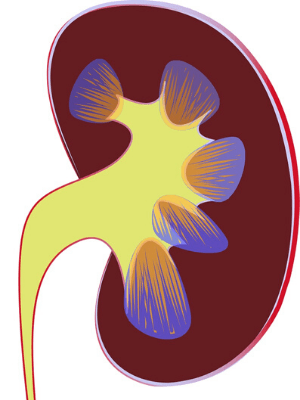🐾 Allow 5-7 minutes to read full post.
Last month we began a conversation about kidney disease, focusing specifically on how cats can be affected and early warning signs. Given that dogs and cats are entirely different species, it doesn’t make sense to discuss kidney disease as though it affects either species in the same way. Kidney failure is more common in cats, but tends to progress quicker in dogs. Today we’ll focus on our canine companions and how kidney issues can manifest, as well as some red flags that may point towards the onset of chronic kidney disease (CKD). If you missed the post about CKD in cats, check it out here.
Last month we began a conversation about kidney disease, focusing specifically on how cats can be affected and early warning signs. Given that dogs and cats are entirely different species, it doesn’t make sense to discuss kidney disease as though it affects either species in the same way. Kidney failure is more common in cats, but tends to progress quicker in dogs. Today we’ll focus on our canine companions and how kidney issues can manifest, as well as some red flags that may point towards the onset of chronic kidney disease (CKD). If you missed the post about CKD in cats, check it out here.
Causes of Kidney Disease in Dogs
Just like with cats, dogs can experience acute or chronic kidney failure. Acute kidney failure typically results from an environmental exposure, such as ingestion of a toxin (examples include ibuprofen, antifreeze, and certain foods such as grapes and raisins).
Chronic kidney disease manifests much more slowly, and it is harder to pinpoint a specific cause for this type of kidney failure. Older dogs are more likely to suffer from CKD than younger dogs.
Kidney disease can develop in dogs for a variety of reasons. One condition that has been associated with the progression of CKD is dental disease. Dogs with advanced dental disease usually have higher concentrations of bacteria in their oral cavities. These bacteria can travel through the blood stream into several internal organs (including the kidneys) and can cause damage. This is one of the many reasons that we stress the importance of dental hygiene! For more information about how to keep your fur baby’s pearly-whites in tip-top shape, read this blog post.
Kidney disease can also occur in dogs that are infected with lyme disease. While it is more typical of a lyme infection to affect the joints, a small percentage of dogs with lyme disease will develop kidney disease. It is important to screen yearly for tick diseases as part of annual wellness exams.
Chronic kidney disease manifests much more slowly, and it is harder to pinpoint a specific cause for this type of kidney failure. Older dogs are more likely to suffer from CKD than younger dogs.
Kidney disease can develop in dogs for a variety of reasons. One condition that has been associated with the progression of CKD is dental disease. Dogs with advanced dental disease usually have higher concentrations of bacteria in their oral cavities. These bacteria can travel through the blood stream into several internal organs (including the kidneys) and can cause damage. This is one of the many reasons that we stress the importance of dental hygiene! For more information about how to keep your fur baby’s pearly-whites in tip-top shape, read this blog post.
Kidney disease can also occur in dogs that are infected with lyme disease. While it is more typical of a lyme infection to affect the joints, a small percentage of dogs with lyme disease will develop kidney disease. It is important to screen yearly for tick diseases as part of annual wellness exams.
Early Signs of Kidney Disease
Many of these symptoms are also observed in cats and were highlighted in last week’s blog post. Click each symptom for more information.
As kidney function decreases, the kidneys are less effective at filtering waste products out of the bloodstream. As blood passes through the kidneys and then exits, some toxins will remain in the bloodstream and continue circulating to other parts of the body. The body will increase blood flow to the kidneys to try to filter out more of the remaining toxins. This causes the kidneys to produce more urine. The kidneys also lose their ability to concentrate urine, and more fluid is lost through urination as a result.
A dog in kidney failure is producing more urine. This loss of fluids increases a dog’s thirst, causing him to consume more water.
These symptoms occur for a multitude of reasons, including the buildup of waste in the bloodstream, an imbalance of electrolytes, a decrease in red blood cell production, lack of appetite, and an increase in high blood pressure.
Dogs with CKD aren’t able to filter out toxins as readily as healthy dogs. The build-up of toxins in their blood stream make them feel sick, and sick pups don’t usually feel like eating.
Bad breath can be due to two reasons: gingivitis (dental disease) and/or toxin buildup. As we mentioned earlier, dental disease can put pets at a higher risk of kidney disease. Toxins build up in the blood stream as the kidneys become less effective at filtering waste products out of the blood. Some of these waste products are acids that have distinct smells and can cause oral ulcers and bad breath.
This is a side effect of toxin accumulations and feeling sick.
Failing kidneys redirect fluid from the GI tract to the kidneys in an attempt to filter out toxins. A decrease in GI fluid results in constipation. Also, as the kidneys lose their ability to concentrate, more fluid in the body is lost. This can cause dehydration and constipation.
Dogs with CKD aren’t eating as much, and they are losing fluid. They rely on their own muscle and fat stores for energy. These factors contribute to a decline in weight.
This is caused by bacterial infections of the kidneys and/or irritation of the bladder lining.
Dogs with advanced kidney disease can develop oral ulcers, which are painful. Pets with ulcers may drool more often or paw at their mouth to express their discomfort. Drooling is also a symptom of nausea.
Our Recommendations
Dogs diagnosed with kidney disease have a short life expectancy overall. Diagnosing this disease early by doing regular bloodwork and urinalyses can make a huge impact on life span and remaining quality of life. At House Paws, we recommend yearly screening for dogs as they approach middle age, and biannual screening for elderly dogs.







